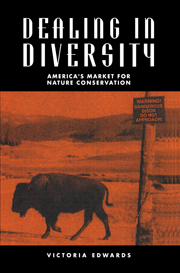Book contents
- Frontmatter
- Contents
- Preface
- Acknowledgments
- 1 Introduction: private provision of conservation
- 2 The conservation market
- 3 Collective action
- 4 Protection mechanisms and incentives
- 5 Fee-hunting
- 6 Watchable wildlife
- 7 Turning development into conservation
- 8 Conservation partners
- 9 Towards a more holistic approach
- References
- Index
4 - Protection mechanisms and incentives
Published online by Cambridge University Press: 19 January 2010
- Frontmatter
- Contents
- Preface
- Acknowledgments
- 1 Introduction: private provision of conservation
- 2 The conservation market
- 3 Collective action
- 4 Protection mechanisms and incentives
- 5 Fee-hunting
- 6 Watchable wildlife
- 7 Turning development into conservation
- 8 Conservation partners
- 9 Towards a more holistic approach
- References
- Index
Summary
Every species, every habitat, every ecosystem presents [the Conservancy with] a different challenge. Our conservation strategy must vary accordingly. … We must, in short, be able to match our protection tools with the task at hand.
The Nature Conservancy, 1989Protection mechanisms
The success of conservation on private land in the United States has often been attributed to the ability of conservation organizations to act in a flexible manner. Conservation of natural habitat on private land in the USA relies on a number of formal and informal arrangements to ensure proper protection and management of the land:
fee simple ownership (through purchase, bargain sale or donation);
conservation easement (through purchase or donation);
management agreement;
lease; and
informal agreement.
The suitability of each type of mechanism depends upon the type of habitat being protected and the type and distribution of values associated with the site. In most cases some form of property right is acquired from the landowner's interest, in order to achieve protection of a natural area. The interest held by a landowner is referred to as a ‘fee simple’ interest. The imagery of a ‘bundle of sticks’ is often used to explain the interest held, where each of the sticks represents a right associated with the property. The entire bundle of sticks can be acquired by acquiring the fee simple interest. Fee simple ownership affords the ultimate protection to an individual or organization wishing to conserve natural habitat.
- Type
- Chapter
- Information
- Dealing in DiversityAmerica's Market for Nature Conservation, pp. 58 - 71Publisher: Cambridge University PressPrint publication year: 1995



